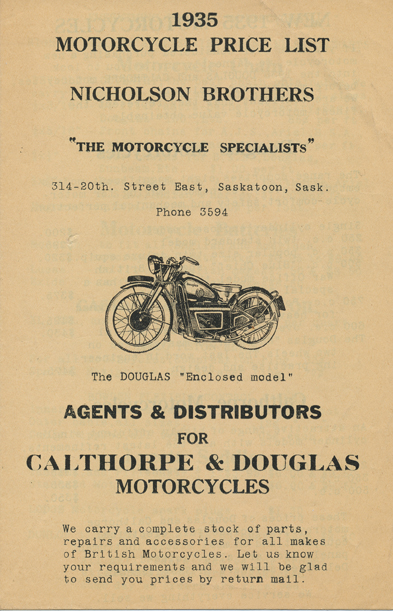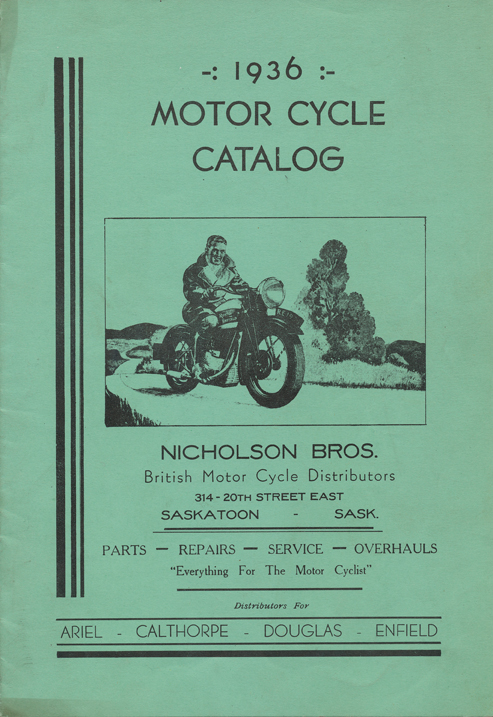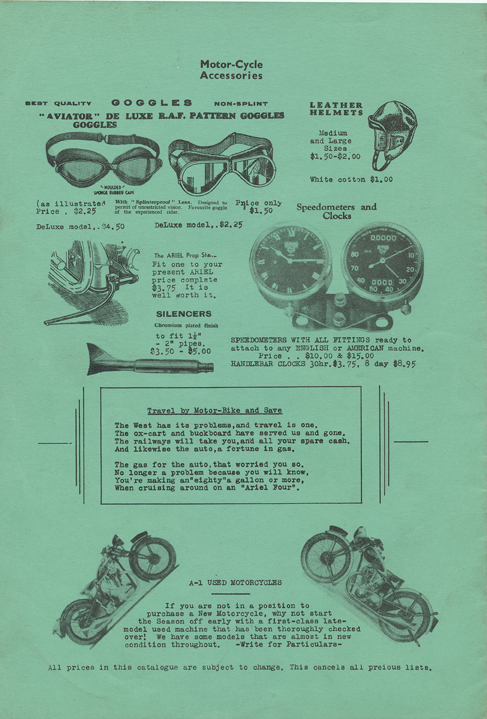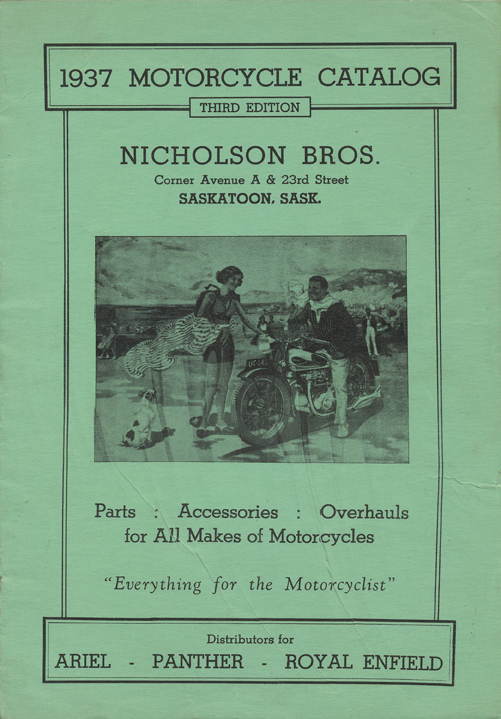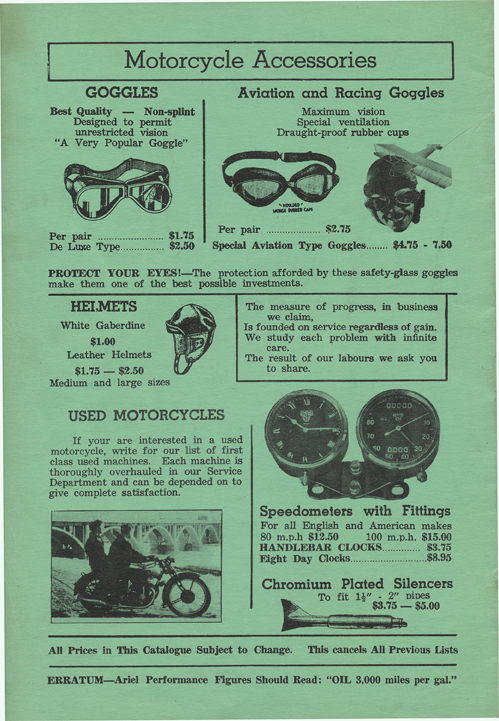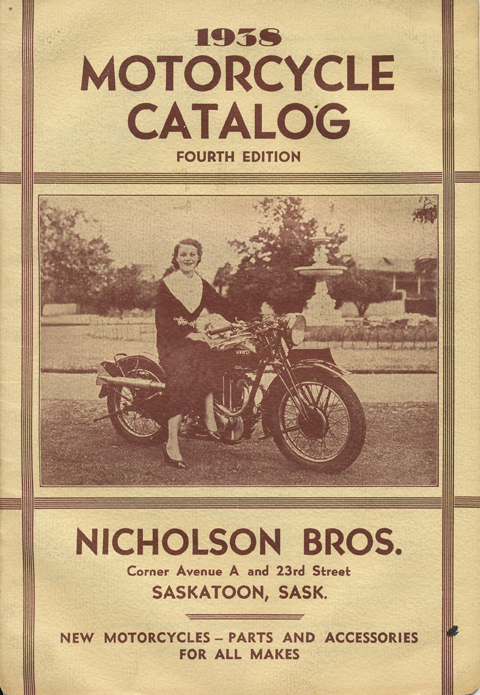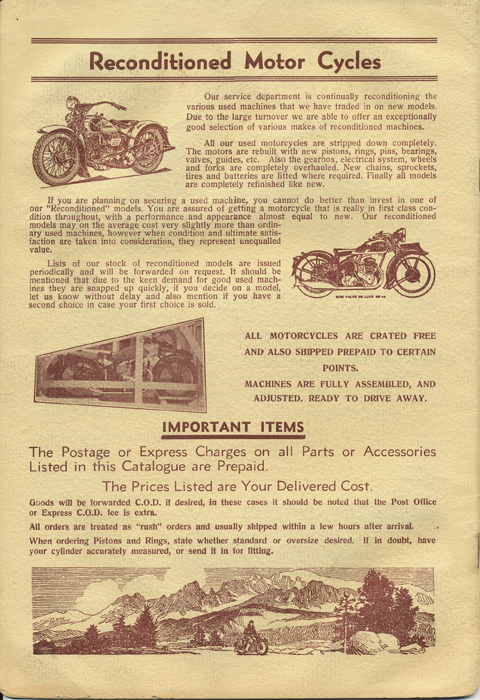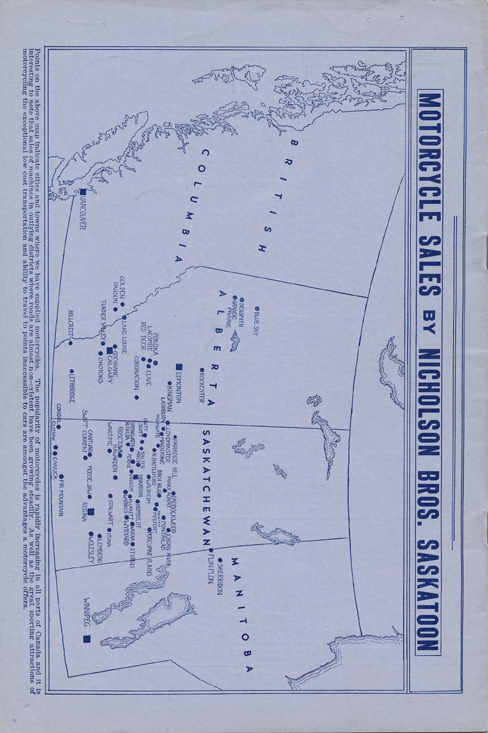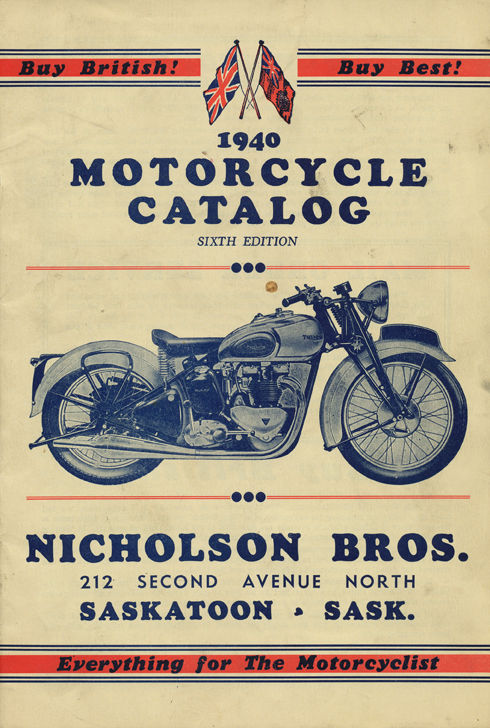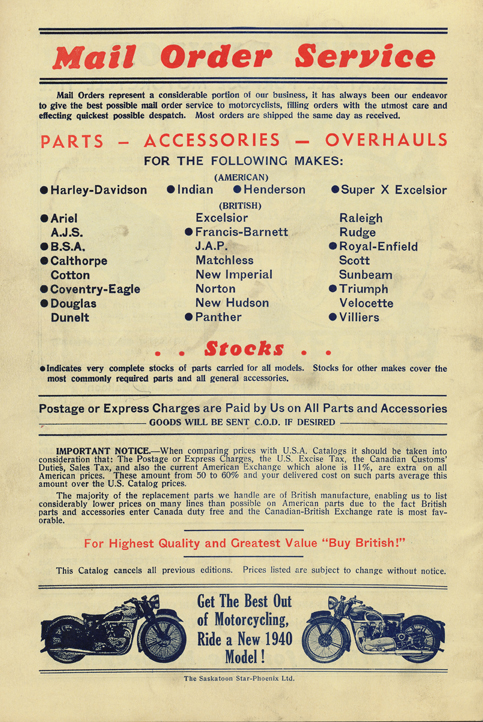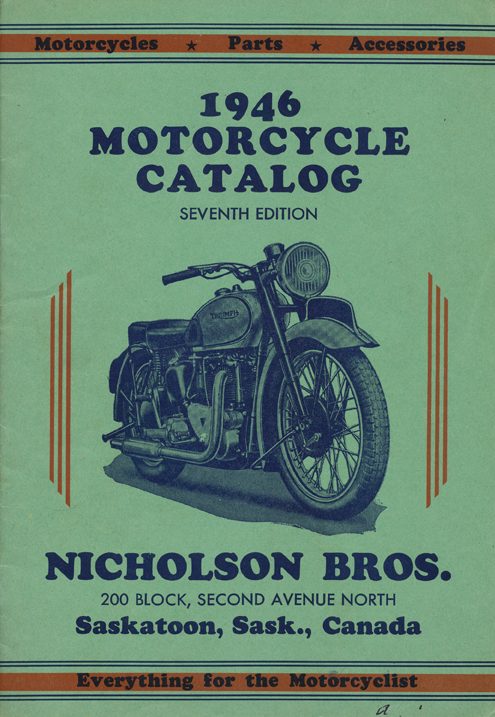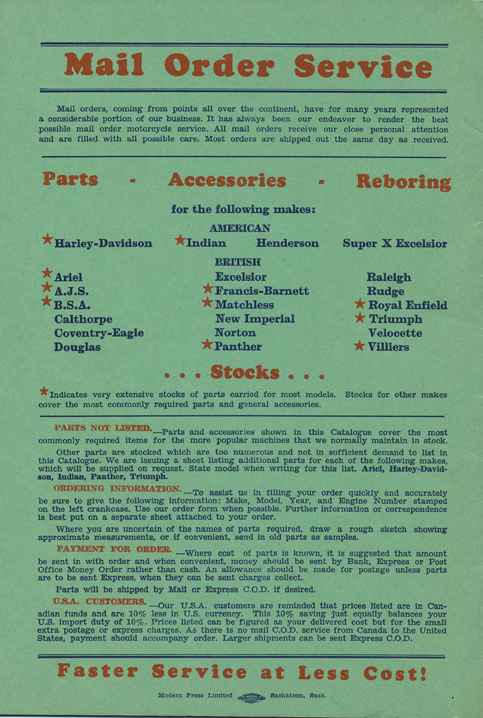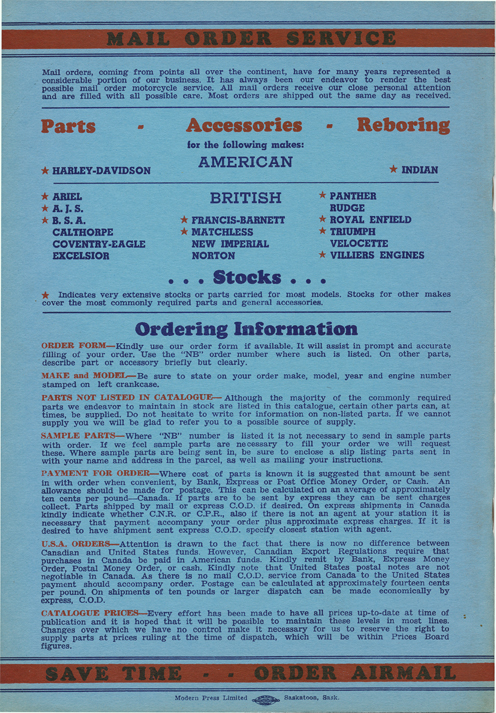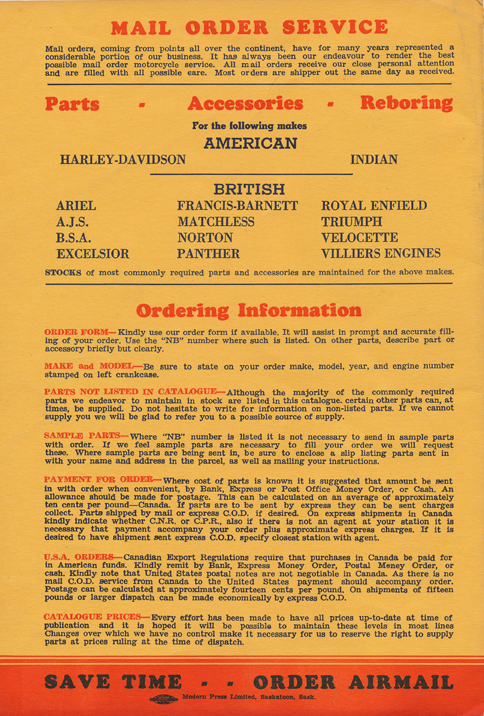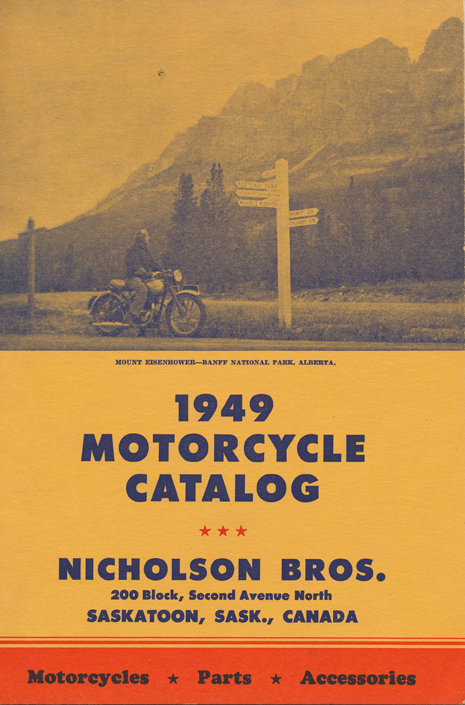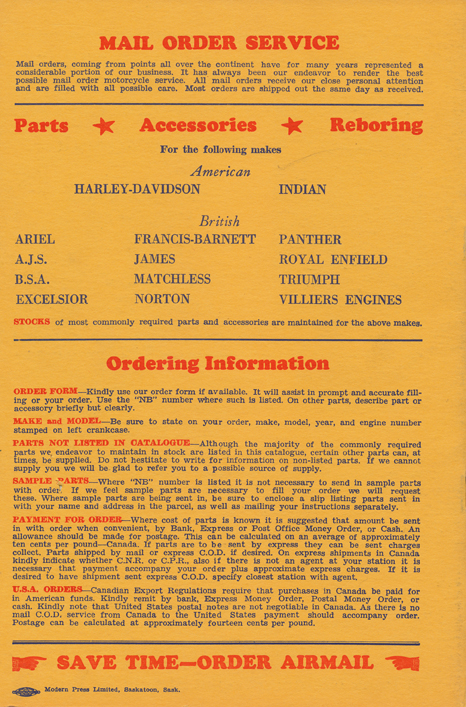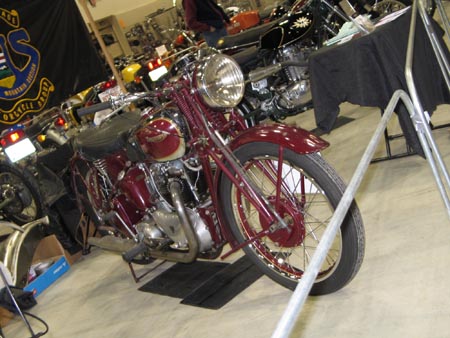Connect with Modern Motorcycle Mechanics on Facebook — become a fan!
May 2010:
Before Clymer and before Haynes service manuals, there was J.B. Nicholson and Modern Motorcycle Mechanics.
Nicholson, together with his brother Lawrence, opened Nicholson Bros. Motorcycles in Saskatoon, Saskatchewan, Canada in 1931. To this small city in the middle of the Canadian prairie they imported DOT, Calthorpe and Douglas motorcycles and by 1935, the brothers had transformed the business into a fledgling mail order parts supply house.
But it was a 25-year old J.B. (Bernie) Nicholson who published what could be considered one of the first comprehensive texts regarding the operation and maintenance of motorcycles of the day. In 1942 the first edition of Modern Motorcycle Mechanics was distributed widely. They sold the book themselves, and industry giants such as Johnson Motors bought books for resale in their showroom. Floyd Clymer himself ordered hundreds of copies for resale through his motoring catalogs.
Nicholson went on to revise his book six times, with editions appearing in 1945, 1948, 1953, 1965, 1969 and the final and seventh in 1974.
Over the years more than 100,000 copies of Modern Motorcycle Mechanics books have sold worldwide from Canada to England, India, South Africa, Australia and beyond.
How many ‘cyclists has this manual helped keep their iron on the road?
I’m happy to say that there is now a book about Nicholson and his contribution to motorcycling with his Modern Motorcycle Mechanics series. Prairie Dust, Motorcycles and a Typewriter: The Story of Bernie Nicholson and Modern Motorcycle Mechanics includes plenty of photographs, and a large chapter dedicated to his time in the Canadian Army training mechanics and dispatch riders and testing machines such as the Harley-Davidson WLC and XA. Prairie Dust, Motorcycles and a Typewriter is of interest to anyone with even just a passing interest in American and British motorcycles. Nicholson’s career spanned the halcyon days of the British motorcycle industry, and there is correspondence between Nicholson and the great engineers such as Edward Turner and Bert Hopwood.
Included is a chapter of anecdotes contributed by enthusiasts who, at some point, have used Modern Motorcycle Mechanics.
To order your copy of Prairie Dust, Motorcycles and a Typewriter for $20 plus $10.50 shipping, visit www.modernmotorcyclemechanics.com.
ALSO, please note, the 2010 Seventh Edition reprint of the motorcyclist’s bible, Modern Motorcycle Mechanics, is now available for $49 CDN plus shipping. This is not a corner copy store reprint, but a professionally scanned and bound, limited hand-numbered edition. Visit www.modernmotorcyclemechanics.com to order your copy.
The story below first ran in Walneck’s Classic Cycle Trader in 2002.
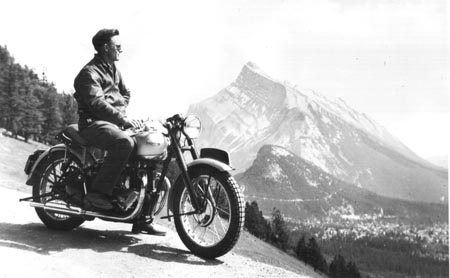
An early post-war Triumph with the town of Banff, Alberta, in the lower right and
Mount Rundle in the background. Bernie Nicholson rode the Triumph from
Saskatoon, Saskatchewan, to Banff, a total of 460 miles.
BERNIE NICHOLSON: CANADIAN MOTORCYCLING LEGEND
Although there are many enthusiastic and talented individuals restoring and preserving motorcycles, Canada has never boasted a motorcycle manufacturing industry as has the United States, and Britain.
Yet, Canada does have a unique motorcycle claim to fame.
His name is J.B. (Bernie) Nicholson.
Starting in 1933, Nicholson and his brother Lawrence operated Nicholson Brothers Motorcycles in Saskatoon, a small city in the province of Saskatchewan, just north of the Dakotas. The Nicholson brothers started working from a shed built out of packing crate material, and moved several times before finally, in the mid-1950s, designing and constructing their ideal modern dealership. It was as up-to-date as possible, with a brick and marble facade, large showroom, full inventory of parts, large machine shop and hydraulic floor hoists for motorcycle service. Over their 60 years in business, the brothers sold A.J.S., Ariel, B.S.A., Matchless, Norton, Royal Enfield, Panther, Sunbeam, Triumph, Villiers, and Indian motorcycles.

Lawrence Nicholson, left, and Bernie with some of their favourite motorcycles in Saskatoon, Sask.
Motorcycle sales in Saskatoon were anything but brisk, and Nicholsons relied mainly on mail order trade. Sales catalogs published and distributed by the brothers served as a wish list for motorcyclists, as the books highlighted the improvements to the latest models, and listed many parts and accessories.
But Bernie Nicholson is not recognized only as a motorcycle retailer. He is perhaps more widely known as the author of seven editions of the motorcyclist’s bible, Modern Motorcycle Mechanics. In 1942, Nicholson took it upon himself to write a book that would serve riders of a variety of machines. In the late 1930s and early 1940s, many new British motorcycles did not come with repair manuals. And this was at a time before Haynes’ or Clymers’ manuals were a fixture in the library or workshop.
One factor that contributed to Bernie writing his first manual was the advent of war in 1939. Service and repair knowledge of the American machines in service overseas was severely limited, and as Bernie had contributed technical articles to Graham Walker, editor of Motor Cycling, he was enlisted to help. The men were having difficulty with the Indian manual, which was more a parts list besides being printed in French. They asked Motor Cycling for help, and they got it, from Nicholson.
In a letter from Graham to Bernie dated October 31, 1941, Graham writes, “It is difficult to express in words just how much I appreciate the trouble you have gone to. You possess the happy knack of describing the necessary work in such a concise manner and in such a logical sequence as to make it understandable to even inexperienced fitters, and yet, at the same time, suitable for the first-class mechanic.”
After writing technical articles for Graham and other publications, Bernie felt inspired to produce a complete manual.
“There was little done by others in the way of compiling a motorcycle manual, and I considered a manual a necessity. The manuals that may have come from a manufacturer were good, so far as they went. But we had machines going to remote corners of this country, with no repair facilities at hand. The manufacturer’s manuals missed a lot of things that could only be gained by personal experience,” Bernie says.
The first 4,000 copies of the first edition of Modern Motorcycle Mechanics was published in 1942. It sold so well that a second edtion was published in 1944. Updates were made in subsequent editions. Nicholson himself was most pleased with his seventh and final edition. In the seventh edition, Nicholson covers almost every model of British, American, and Japanese motorcycle. This edition includes chapters on Motorcycle Design, Operation, and Maintenance, with individual chapters covering models from Ariel to Yamaha. This is a hard-cover volume of 763 fact filled pages. To date, 100,000 copies of this publication have been sold worldwide.
Bernie recalls filling a wooden motorcycle packing crate with 500 copies for shipment to Australia, and shipping another order to Malawi, South Africa.
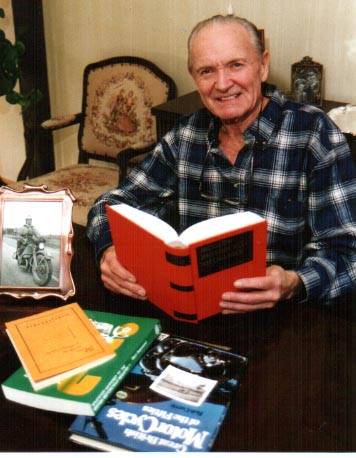
Left: J.B. Nicholson’s First Edition of Modern Motorcycle Mechanics was published in 1942, and Right: his Seventh Edition was published in 1974. Bernie was, of course, proudest of the final edition of MMM, a book that includes chapters on every major make of motorcycle, and several maintenance and service chapters.

Bernie Nicholson tested the experimental shaft-drive opposed twin Harley-Davidson XA during his time as a Captain with the Royal Canadian Electrical Mechanical Engineers. This photo circa 1943.
In late 2000, 74-year old Durham, North Carolina, resident Perry Colwell attended the Antique Motorcycle Club of America national road run in Nelson, B.C. I was there for the event, and introduced myself to Colwell when I saw the 1962 BMW R69S he was riding. After talking for a few moments, Nicholson’s name came up in the conversation.
Colwell lit up, and said, “My memories of Canada and motorcycles go back to Saskatoon’s J.B. Nicholson and his book, Modern Motorcycle Mechanics. The first time I saw Modern Motorcycle Mechanics, I dug out a map to find out where Saskatoon was and where Nicholson came from.
“I loved that book, and in fact, I wore out three editions. I bought my first copy in the late 1940s, when I was riding an Indian 741. I learned everything I needed to know from Modern Motorcycle Mechanics–Nicholson and his book touched a lot of lives,” Colwell reports.
Colwell currently owns the 1962 BMW, as well as a 1969 BMW R69S outfit, a 1941 Indian 741, a 1952 B.S.A. Gold Star, and more modern machines such as a 1999 Suzuki SV650 and a 1999 Ducati Monster. He says he still refers to Modern Motorcycle Mechanics when he is working on one of his older machines.
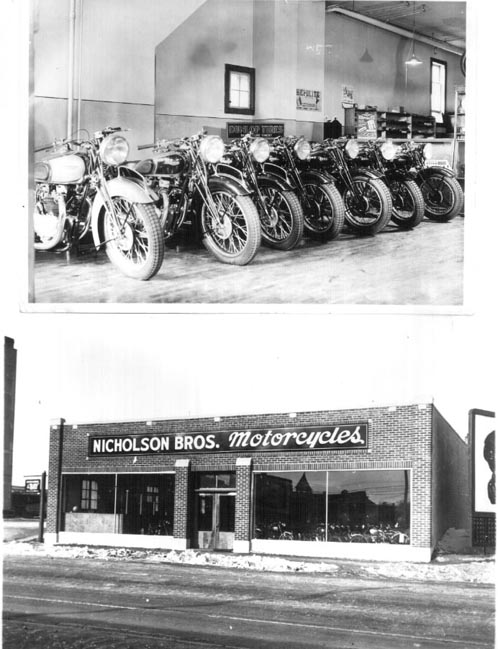
TOP: A corner of the Nicholson Bros. Motorcycles shop in 1939,
with parts counter in background. Ah, to step back in time.
BOTTOM: Completed in 1946, this shop drafted by Bernie and Lawrence Nicholson was built across from Saskatoon City Hall, and was ready for a busy import, parts and service business. The brothers built and moved again in the 1950s.
Another Nicholson devotee is British motorcycle enthusiast Geoffrey Follin. From San Francisco, Follin was aboard a 1930 Norton ES2 outfit when I recently caught up with him in Death Valley, during Max Bubeck’s 15th annual Death Valley Run. (Read the story about Max and his D.V. Run elsewhere on this website.)
Says Follin of Bernie Nicholson and Modern Motorcycle Mechanics, “Nicholson was just incredible–he put together service and technical information so guys with questions could have one book in their hands, and work through nine out of 10 problems.”
Follin also speaks highly of Nicholson as a parts retailer. Nicholson moved to Calgary in 1977, and continued his British mail-order parts business until he retired in 1993. Upon retirement, he sold the majority of his spares to a New Zealand enthusiast. But prior to Nicholson’s retirement, Follin purchased a speedometer for his military model 1951 B.S.A. B31.
“I had one of Nicholson’s old mail-order catalogs, and he listed speedos for sale,” Follin recalls. “I called Bernie, and he said he had a speedo that would suit the B.S.A.
“‘How about I send you the speedometer, and you send me the money when you get it’, Bernie said. I couldn’t believe it. He didn’t know me.
Bernie then said, ‘I’m a pretty good judge of character.’ He was very trusting,” Follin concludes.
When repairing his 1930 Norton, Follin will refer to a Norton manual.
But if I can’t find the information I’m looking for in there, I look in Nicholson’s book–often I can piece together enough information to make an educated guess.
“God love him,” Follin continues. “Every time I look at Modern Motorcycle Mechanics, I think about how important it was that Nicholson put the book together, that he actually got the information down on paper and disseminated his knowledge.
“Nicholson has kept a lot of bikes on the road, and his book is truly a gift that he has given to motorcycling.”
Bernie’s brother Lawrence Nicholson retired in 1977 and remained in Saskatoon. He died in 1991.
Bernie, who had unfortunately suffered from advanced Alzheimers for the last several years passed away peacefully on Dec. 17, 2001. He was 84 years old and was a resident at the highly regarded Colonel Belcher veteran care center in Calgary, Alberta. I have known Bernie since 1991, and interviewed and visited with him many times. I used to tell him we’d fit an Ariel Square Four motor to his wheelchair–he always smiled at the suggestion.
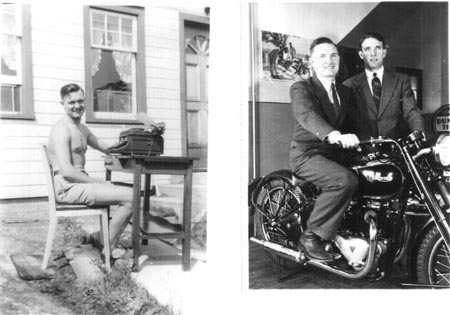
LEFT PHOTO: Bernie Nicholson at work, writing the first edition of Modern Motorcycle Mechanics
RIGHT PHOTO: Bernie Nicholosn (left) and brother Lawrence pose with a Triumph twin in one of their earlier Saskatoon showrooms.
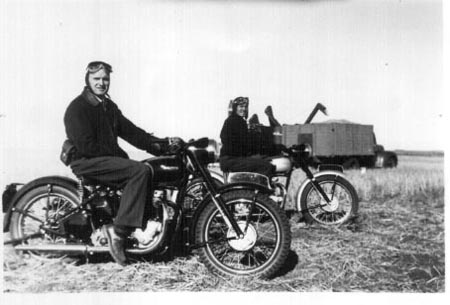
Bernie Nicholson (front), and brother Lawrence (rear), astride a 1950 Triumph Speed Twin and a T100 in the middle of the Saskatchewan prairie where Bernie learned the basic mechanics that led to Modern Motorcycle Mechanics.
A range of Nicholson Bros. catalogs, staring with their very first in 1935.
1939 Triumph Speed Twin: This is my 1939 Triumph Speed Twin, “rustored” by John Whitby. I acquired this machine from the estate of J.B. (Bernie) Nicholson, of Nicholson Bros. Motorcycles fame. Bernie is famous for his seven editions of Modern Motorcycle Mechanics, the bible for any British ‘cycle enthusiast.
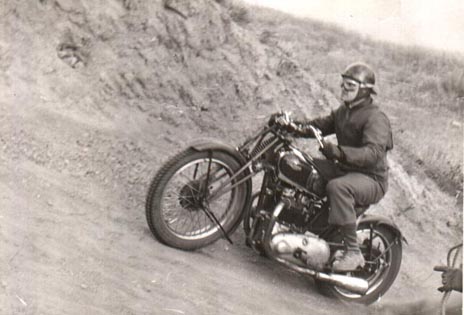
Bernie Nicholson hillclimbing the 1939 Triumph 5T Speed Twin in Saskatoon,
circa 1939

Forward momentum ends, Bernie Nicholson with the 1939 Triumph 5T Speed Twin, circa 1939
When the Triumph came home it was set up as a hill climb machine. Bernie had a set of megaphones on the bike, but for some reason he’d removed the girder front end. I began a search for the correct girder and was finally able to locate a 1940 girder fork, which has the helper, or check springs, on the side. While technically incorrect for the 1939 machine, it was better than nothing! My own motorcycle accident put this project to the side. But when John offered to put the bike together I didn’t hesitate. This motorcycle wears all of its original patina. John painted and distressed the fork, headlight and front fender. The mufflers also were ‘beaten’ to give them a weathered look. It took very little to persuade the Triumph to run. It likes to smoke a bit, but I think we’ll leave it as is for a while longer.
Your comments on Bernie and the Nicholson Bros. are appreciated, thanks for reading.
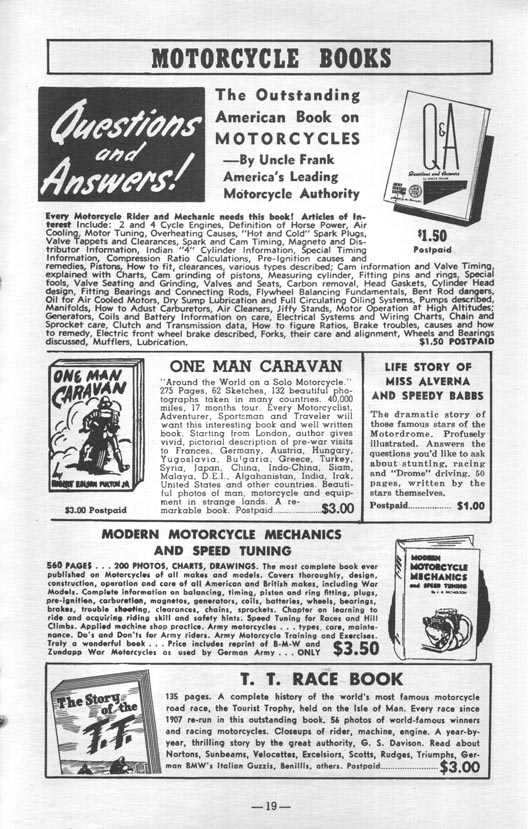 A page from Catalog No. 107 of Floyd Clymer’s Popular Motor Books catalog; Showing America’s Most Complete Line of Books Pertaining to Automobiles and Motorcycles. The address is Clymer Motors 1268 So. Alvarado St. Los Angeles 6, Calif. I believe the ad would be for the First Edition. This is in response to Dave Lyon’s comment, seen below.
A page from Catalog No. 107 of Floyd Clymer’s Popular Motor Books catalog; Showing America’s Most Complete Line of Books Pertaining to Automobiles and Motorcycles. The address is Clymer Motors 1268 So. Alvarado St. Los Angeles 6, Calif. I believe the ad would be for the First Edition. This is in response to Dave Lyon’s comment, seen below.



